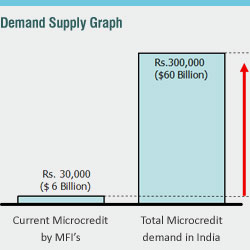|
India has 800 million poor people who live on the brink of subsistence. This is one of the largest populations of poor in the world. The bottom 5% of India’s poor, considered “ultra poor”, face even deeper levels of chronic hunger, persistent poor health, and illiteracy.
To cope with their vulnerability, the poor have no choice but to take loan for consumption and income generation from money lenders that charge exploitative rates of interest. This can put the poor in a debt trap. If poor people can access loans with fair interest rates, they could break out of the cycle of poverty. Bureaucracy, corruption, illiteracy and challenging logistics prevent the poor from accessing loans from banks and the government.
Microfinance in India started in 1974 in Gujarat as Shri Mahila SEWA (Self Employed Women’s Association) Sahakari Bank. Registered as an Urban Cooperative Bank they provided banking services to poor women employed in the unorganized sector. Microfinance later evolved in the early 1980s around the concept of informal Self- Help Groups (SHGs) that provided deprived poor people with financial services. From modest origins, the microfinance sector has grown at a steady pace. Now in a strong endorsement of microfinance, the National Bank for Agriculture and Rural Development (NABARD) and Small Industries Development Bank of India (SIDBI) have committed themselves to developing microfinance.
The microfinance sector has been witnessing a tremendous growth during the last few years in India in terms of loan portfolio, geographical area and outreach. With India’s GDP growing at the rate of 7.1 per cent the country’s socio-economic pyramid is turning around the story with millions of poor people becoming entrepreneurs.
Delivery models of microfinance in India
- Direct Financing Model: In this model known also as Micro Finance Institution Model, the bank lends to an NGO. The NGO promotes and imparts training to the Self Help Groups and also gives credit to them. This model in India is characterized by a diversity of institutional and legal forms. MFIs in India exist in a variety of forms like trusts registered under the Indian Trust Act, 1882/Public Trust Act, 1920; societies registered under the Societies Registration Act, 1860; Co-operatives registered under the Mutually Aided Cooperative Societies Acts of the States; and non-banking financial companies (NBFC)-MFIs, which are registered under Section 25 of the Companies Act, 1956 or NBFCs registered with the Reserve Bank. These MFIs are scattered across the country and due to the multiplicity of registering authorities, there is no reliable estimate of the number of MFIs. The most frequently used estimate is that their number is likely to be around 800. Attempts have been made by some of the associations of MFIs like Sa-Dhan to capture the business volume of the MFI sector. As per the Bharat Micro Finance Report of Sa-Dhan, in March 2008, the 223 member MFIs of Sa-Dhan had an outreach of 14.1 million clients with an outstanding micro finance portfolio of Rs.5,954 crore.
- Self Help Group Bank Linkage Model: In this model SHGs act as a bridge between bankers and the grass root clients. Banks transfer funds to micro finance bodies that are responsible for disbursal and collection. The intermediation cost could be around 6% of the loan amount. The risk completely lies with the banks - the advances to the SHGs would be reflected in the portfolios of the banks. Banks do not mind taking the risk a s servicing the grass-root level customers who are illiterate would otherwise involve a lot of transaction costs. A majority of these grass-root level customers have no means to produce ration card, identity card and even filling up application forms, which are the bare requirements to obtain loans in the normal course of bank lending operations. NABARD oversees the linking programme of banks to SHGs and offers refinance for it whereas SIDBI, through the SIDBI foundation for microcredit (SFMC) lends to Micro Finance Institutions. The Self-Help Group-Bank Linkage Programme implemented by commercial banks, Regional Rural Banks and Co-operative banks has emerged as a major micro finance programme in India, with 1.6 million SHGs being linked to banks in 2004-05 with the total flow of credit to them of over Rs. 6,800 crores.
|
|
|













